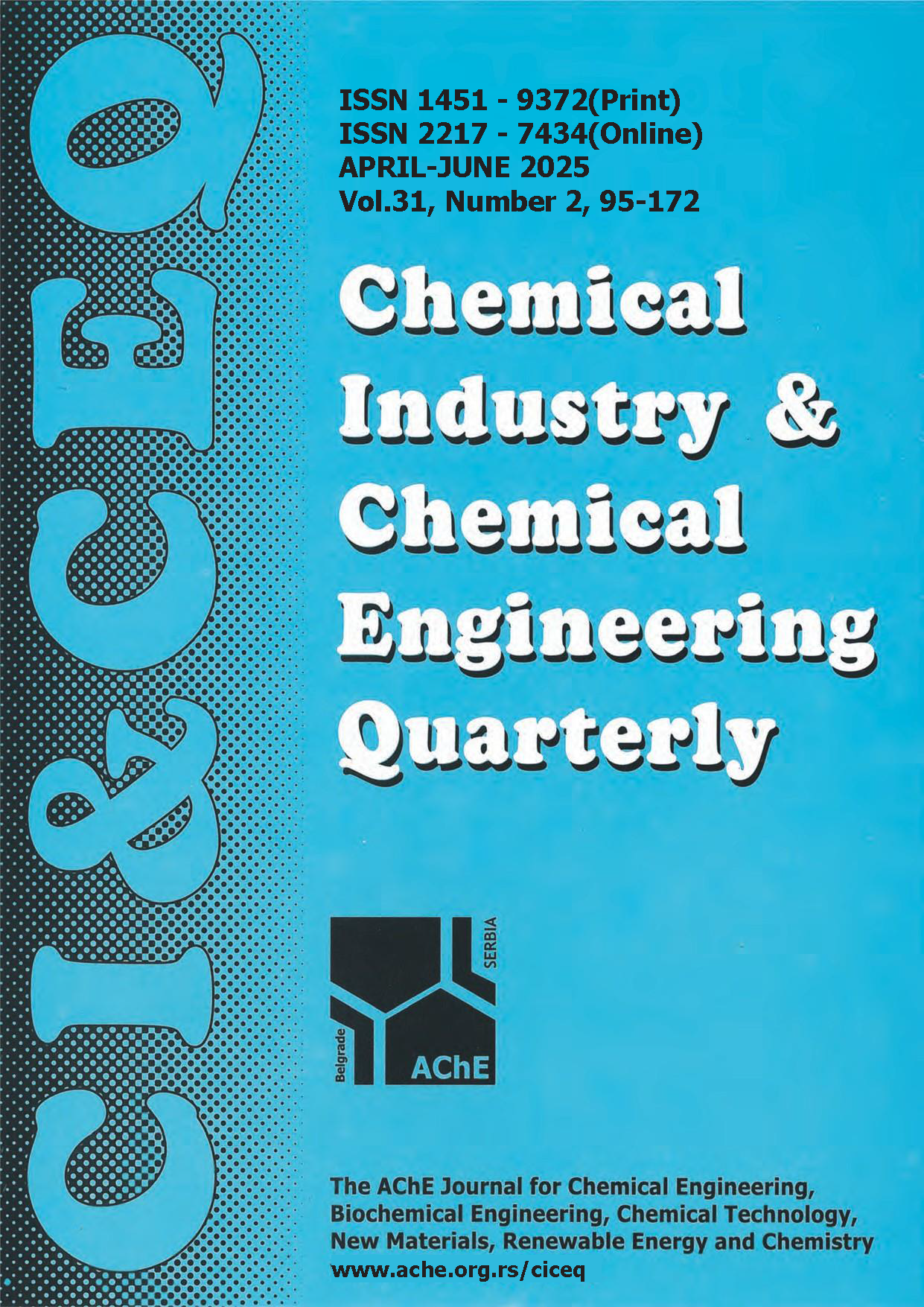AN ENVIRONMENTALLY FRIENDLY INDIGO DYEING PROCESS USING IRON (II) GLUCONATE AS A REDUCING AGENT
Original scientific paper
DOI:
https://doi.org/10.2298/CICEQ240106022AKeywords:
Indigo dyeing, density functional theory, ecological process, iron (II) gluconate, process optimizationAbstract
This research paper aims to replace the ecologically harmful sodium dithionite traditionally used in the indigo dyeing process with the iron (II) gluconate reducing agent. The density functional theory (DFT) method using the B3LYP 6-311 G(d,p) basis set was used to determine the optimized structures of iron(II) gluconate and indigo. The highest occupied molecular orbital (HOMO) energy and the lowest unoccupied molecular orbital (LUMO) energy were calculated, and the electronic properties dependent on HOMO-LUMO energies were determined. Furthermore, an ecological dyeing process using this reducing agent was studied. The influences of alkalinity, reduction temperature, and iron(II) gluconate concentration on the fulfillment of the dyeing process were inspected by measuring the obtained redox potential and the color strength of the dyed samples. A full factorial experiment was performed for statistical analysis and optimization of the dyeing process. The results revealed that the developed method is highly effective and capable of generating redox potential and dyeing quality comparable to those obtained with the conventional process employing sodium dithionite. Finally, the substitution of sodium dithionite with iron (II) gluconate reduced the wastewater load generated by the conventional dyeing process.
References
[1] L. Xiaoyan, K. Wang, M. Wang, W. Zhang, J. Yao, S. Komarneni, J. Clean. Prod. 276 (2020) 123251. https://doi.org/10.1016/j.jclepro.2020.123251.
[2] T. M. Hsu, D.H. Welner, Z.N. Russ, B. Cervantes, R. L. Prathuri, P. D. Adams, J. E. Dueber, Nat. Chem. Biol. 24 (2018) 256—261. https://doi.org/10.1038/nchembio.2552.
[3] X.Y. Wang, S.C. Sevov, Chem. Mater. 19 (2007) 4906—4912. https://doi.org/10.1021/cm071480x.
[4] M. Abdelileh, A.P. Manian, D. Rhomberg, M. Ben Ticha, N. Meksi, N. Aguiló-Aguayo, T. Bechtold, J. Clean. Prod. 266 (2020) 121753. https://doi.org/10.1016/j.jclepro.2020.121753.
[5] T. Bechtold, E. Burtscher, A. Turcanu, O. Bobleter, Text. Res. J. 67 (1997) 635—642. https://doi.org/10.1177/004051759706700902.
[6] T. Bechtold, A. Turcanu, J. Appl. Electrochem. 34 (2004) 1221—1227. https://doi.org/10.1007/s10800-004-1707-z.
[7] A. Turcanu, C. Fitz-Binder, T. Bechtold, J. Electroanal. Chem. 654 (2011) 29—37. https://doi.org/10.1016/j.jelechem.2011.01.040.
[8] C. Yi, X. Tan, B. Bie, H. Ma, H. Yi, Sci. Rep. 10 (2020) 4927—4928. https://doi.org/10.1038/s41598-020-61795-5de.
[9] Y. Changhai, T. Xiaodong, Z. Yang, X. Jie, Z. Hantao, L. Xueding, Z. Danying, H.Ping, Z. Jin, (Wuhan Textile University), CN201710044213.8A (2017).
[10] L. Xiaoyan, W. MengQian, W. Gang, Y. Jiming, Pigm.
Resin. Technol, 50 (2021) 185—193. http://dx.doi.org/10.1108/PRT-04-2020-0035.
[11] N. Meksi, M. Kechida, F. Mhenni, Chem. Eng. J. 131 (2007) 187—193. https://doi.org/10.1016/j.cej.2007.01.001.
[12] N. Meksi, M. Ben Ticha, M. Kechida, M.F. Mhenni, Chem. Res. 49 (2010) 12333—12338. https://doi.org/10.1021/ie100974.
[13] N. Meksi, M. Ben Ticha, M. Kechida, M.F. Mhenni, J. Clean. Prod. 24 (2012) 149—158. https://doi.org/10.1016/j.jclepro.2011.11.062.
[14] J.N. Chakraborty, R.B. Chavan, AATCC Rev. 4 (2004) 17—20. https://www.researchgate.net/publication/290277788_Dyeing_of_cotton_with_vat_dyes_using _ironII_salt_complexes.
[15] J.N. Chakraborty, M. Das, R.B. Chavan, Melliand Int. 12 (2005) 319—323. https://www.researchgate.net/publication/290652040_Kinetics_of_dyeing_and_properties_of_ ironII_salt_complexes_for_reduction_of_vat_dyes.
[16] R.B. Chavan, J.N. Chakraborty, Color. Technol. 117 (2001) 88—94. https://doi.org/10.1111/j.1478-4408.2001.tb00340.x.
[17] T. Koopmans, Physica 1 (1933) 104—113. https://doi.org/10.1016/S0031-8914(34)90011-2.
[18] V.C. Mudnoor, J.N. Chakraborty, Fibers Polym. 21 (2020) 1061—1070. https://doi.org/10.1007/s12221-020-9247-7.
[19] J.H. Xin, C.L. Chong, T. Tu, Color. Technol. 116 (2000) 260—265. https://doi.org/10.1111/j.1478-4408.2000.tb00044.x.
[20] P. Kubelka, F. Munk, Zh. Tekh. Fiz. 12 (1931) 593—601. https://www.graphics.cornell.edu/~westin/pubs/kubelka.pdf.
[21] M. Ben Ticha, N. Meksi, N. Drira, M. Kechida, M.F. Mhenni, Ind. Crops. Prod. 46 (2013) 350—358. https://doi.org/10.1016/j.indcrop.2013.02.009.
[22] F. Harrlekas, Doctoral thesis, Institut National Polytechnique de Lorraine (2008). https://hal.univ-lorraine.fr/tel-01752986/document.
[23] J. Rodier, C. Bazin, J. Broutin, P. Chambon, H. Champsaur, L. Rodi, L’analyse de l’eau: Eaux naturelles eaux résiduaires eaux de mer, Dunod, Paris (1996), p.1384. ISBN: 978-2-10-002416-2.
[24] M.E.R. Carmona, M.A.P. Da Silva, S.G.F. Leite, Process Biochem. 40 (2005) 779—788. http://doi.org/10.1016/j.procbio.2004.02.024.
[25] A.Y. Musa, A.H. Kadhum, A.B. Mohamad, A.A. Rahoma, H. Mesmari, J. Mol. Struct. 969 (2010) 233—237. http://doi.org/10.1016/j.molstruc.2010.02.051.
[26] G. Gece, S. Bilgic, Corros. Sci. 51 (2009) 1876—1878. https://doi.org/10.1016/j.corsci.2009.04.003.
[27] I.B. Obot, N.O. Obi-Egbedi, S.A. Umoren, Int. J. Electrochem. Sci. 4 (2009) 863—877. https://www.researchgate.net/publication/261725755_Adsorption_Characteristics_and_Corrosion_Inhibitive_Properties_of_Clotrimazole_for_Aluminium_Corrosion_in_Hydrochloric_Acid.
[28] K. Sayin, D. Karakaş, N. Karakuş, T.A. Sayin, Z. Zaim, S.E. Kariper, Polyhedron 90 (2015) 139—146. https://doi.org/10.1016/j.poly.2015.01.047.
[29] K. Fukui, Science 218 (1982) 747—754. https://www.science.org/doi/10.1126/science.218.4574.747.
[30] T. Karakurt, M. Dinçer, A. Çukurovalı, I. Yılmaz, J. Mol. Struct. 991 (2011) 186—201. https://doi.org/10.1016/j.molstruc.2012.05.022.
Downloads
Published
Issue
Section
License
Copyright (c) 2023 Maha Abdelileh, Manel Ben Ticha , Nizar Meksi, Hatem Dhaouadi

This work is licensed under a Creative Commons Attribution-NonCommercial-NoDerivatives 4.0 International License.
Authors who publish with this journal agree to the following terms:
Authors retain copyright and grant the journal right of first publication with the work simultaneously licensed under a Creative Commons Attribution License that allows others to share the work with an acknowledgement of the work's authorship and initial publication in this journal.
Authors grant to the Publisher the following rights to the manuscript, including any supplemental material, and any parts, extracts or elements thereof:
- the right to reproduce and distribute the Manuscript in printed form, including print-on-demand;
- the right to produce prepublications, reprints, and special editions of the Manuscript;
- the right to translate the Manuscript into other languages;
- the right to reproduce the Manuscript using photomechanical or similar means including, but not limited to photocopy, and the right to distribute these reproductions;
- the right to reproduce and distribute the Manuscript electronically or optically on any and all data carriers or storage media – especially in machine readable/digitalized form on data carriers such as hard drive, CD-Rom, DVD, Blu-ray Disc (BD), Mini-Disk, data tape – and the right to reproduce and distribute the Article via these data carriers;
- the right to store the Manuscript in databases, including online databases, and the right of transmission of the Manuscript in all technical systems and modes;
- the right to make the Manuscript available to the public or to closed user groups on individual demand, for use on monitors or other readers (including e-books), and in printable form for the user, either via the internet, other online services, or via internal or external networks.




